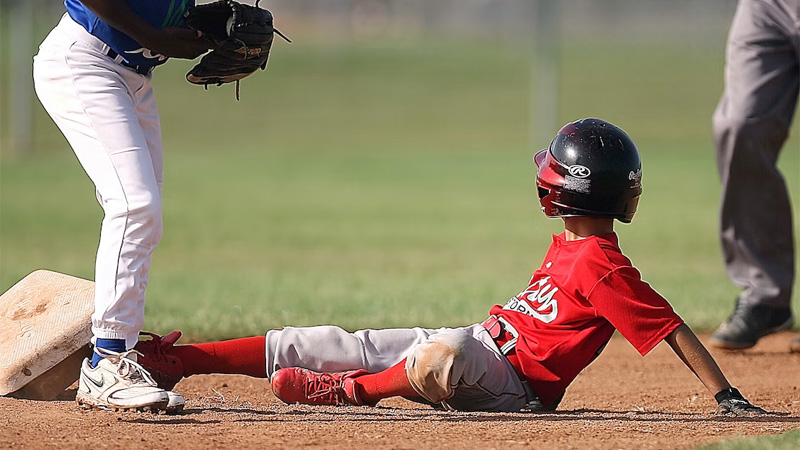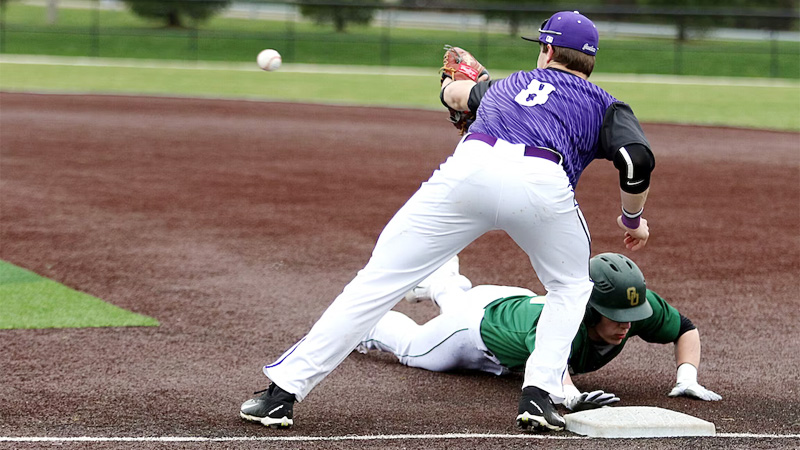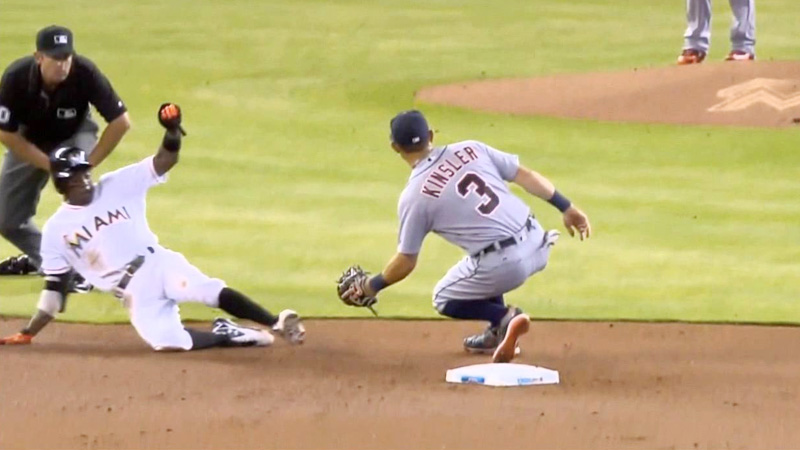Baseball and softball are intricate sports with a myriad of rules and techniques that make them both fascinating and exhilarating to watch. One fundamental play that frequently occurs in these sports is the tag out.
Whether you’re a dedicated fan or a curious newcomer, understanding the concept of a tag out is essential to fully appreciate the dynamics and strategies involved in the game.
In this article, we will delve into the world of tag outs in baseball and softball. We will explore the definition of a tag out, its objectives for the defensive team, and the critical role played by baserunners in avoiding being tagged out.
So, let’s dive into the exciting realm of tag-outs and unravel the intricate tapestry of these captivating plays in America’s favorite pastime.
What Is The Concept of Tag Out?
Understanding the concept of a tag out is essential in grasping the dynamics of baseball and softball. This fundamental play occurs when a defensive player touches a baserunner with the ball or with the hand or glove holding the ball, resulting in the runner being declared out.
A Tag Out in Baseball and Softball
A tag out refers to a play where a fielder, in possession of the ball, physically contacts a baserunner who is not touching a base. This act can be achieved by directly touching the runner with the ball or with the hand or glove holding the ball.
The tag-out rule applies when the ball is live, meaning it is in play, and the baserunner is in jeopardy of being put out.
Objectives of a Tag Out for the Defensive Team
The primary objective of a tag out is to prevent the baserunner from safely advancing to the next base or to record an out when the runner is not in contact with a base.
By executing a successful tag out, the defensive team can halt the progression of baserunners, limit scoring opportunities, and gain control of the game. It is a defensive strategy employed to secure outs and maintain an advantageous position on the field.
Role of the Baserunner in Avoiding a Tag Out
The baserunner plays a pivotal role in avoiding a tag out. Their primary objective is to safely advance to the next base without being tagged by a defensive player. To achieve this, baserunners must exhibit situational awareness, anticipation, and quick reflexes.
They employ various techniques to elude the tag, such as sliding, changing direction, or altering speed to confuse the fielder attempting the tag.
Baserunners must also assess the risk-reward factor when deciding to advance or retreat, taking into account the fielder’s position and the timing of their tag attempt.
Scenarios of Tag Outs in Baseball

There are different scenarios in Tag Outs that matter in this context. Let’s check out the scenarios in the below section.
Stealing Bases and Tag Outs
One common scenario where tag outs occur is during attempts to steal bases. In this situation, the baserunner tries to advance to the next base while the pitcher delivers the pitch. The catcher plays a crucial role in attempting a tag out.
As soon as the catcher receives the pitch, their focus shifts to the baserunner. They must quickly catch the ball and position themselves to make a tag if the runner tries to steal.
The catcher’s ability to react swiftly and accurately apply the tag can make the difference between a successful steal and an out.
Baserunners employ various techniques to avoid being tagged during stealing attempts. They rely on their speed, agility, and timing to outmaneuver the fielder attempting the tag.
Common strategies include the hook slide, where the runner curves their slide to avoid the tag, or the pop-up slide, where they slide feet-first and quickly pop up to confuse the fielder.
Baserunners may also employ dekes or fakes to distract the fielder and create an opportunity to evade the tag.
Force Plays and Tag Outs
Force plays often lead to tag outs and is another significant scenario in baseball. A force play occurs when the baserunner must advance to the next base because the following runner is also attempting to occupy the same base.
For example, when there is a runner on first base and a ground ball is hit, the fielder can field the ball and throw to second base, forcing the runner from first to advance.
In this situation, the fielder’s responsibility is to receive the throw and apply the tag to the baserunner before they reach second base.
The timing, accuracy, and coordination between the fielder and the player covering the base are critical in executing a successful tag out on force plays.
Non-force Tag Outs
Tag-outs can also occur in non-force situations. One example is pick-off attempts by the pitcher. If the pitcher suspects that a baserunner is attempting to steal or gain an extra lead, they may make a quick throw to the base, aiming to catch the runner off guard.
In this case, the fielder at the base must receive the throw and swiftly apply the tag to the baserunner, who is not forced to advance.
Quick fielding and tagging out baserunners can also lead to non-force tag outs. When a ball is hit sharply to the fielder, they have the opportunity to field the ball cleanly and immediately tag the baserunner before they can reach the base.
This requires excellent reflexes, quick reactions, and the ability to secure the ball and make a swift tag.
Strategies and Skills Involved

The tag outplay in baseball and softball involves a combination of strategic decision-making and athletic skills from both the offensive and defensive sides.
This section will explore the strategies employed by the offense to avoid tag-outs and the essential skills required by the defense to execute successful tag-outs.
Offensive Strategies to Avoid Tag Outs
Offensive players aim to minimize the risk of being tagged out, especially when attempting to steal bases or advance to the next base on a hit. To achieve this, they employ various strategies.
Timing of Stealing Bases
Timing is crucial when attempting to steal a base. Baserunners analyze the pitcher’s delivery, paying close attention to their movement and delivery speed.
By studying these cues, they can anticipate the right moment to make their move, increasing their chances of a successful steal. Timing the steal effectively minimizes the opportunity for the defensive team to execute a tag out.
Sliding Techniques to Evade Tags
Sliding is an essential skill for baserunners to avoid being tagged out. Different sliding techniques, such as the hook slide, pop-up slide, or head-first slide, offer different advantages depending on the situation.
These techniques allow runners to quickly change direction, maintain balance, and evade the tag by getting their body to the base before the tag can be applied.
By mastering sliding techniques, baserunners can enhance their chances of avoiding tag-outs and advancing safely.
Defensive Skills Required for Successful Tag Outs
The defensive team must possess certain skills to execute successful tag-outs, which are critical for maintaining control on the field and preventing offensive progress.
Agility and Quick Reaction Time
Defensive players need to react swiftly and move with agility to apply the tag. Whether it’s a catcher attempting to tag a stealing baserunner or an infielder trying to tag a runner on a force play, quick reflexes and the ability to change direction efficiently are essential.
Defensive players must anticipate the baserunner’s movements and adjust their positioning accordingly, allowing them to make a swift and accurate tag.
Accurate Throws and Tagging Techniques
To complete a tag out successfully, the defensive player must make an accurate throw to the receiving fielder who will apply the tag. This requires strong throwing skills, including arm strength, accuracy, and the ability to adjust the throw based on the baserunner’s position.
Additionally, the fielder must employ proper tagging techniques. Whether it’s a glove tag or a hand tag, the fielder must ensure that the tag makes contact with the baserunner before they reach the base, securing the out.
The strategic offensive approaches of timing steals and utilizing effective sliding techniques empower baserunners to minimize the risk of tag-outs.
On the defensive side, agility, quick reactions, accurate throws, and proper tagging techniques are crucial for executing successful tag-outs.
The combination of these strategies and skills contributes to the competitive nature of baseball and softball, adding an element of athleticism, decision-making, and excitement to the game.
Significance of the Tag Out Rule
The tag-out rule in baseball and softball plays a significant role in shaping the dynamics of the game. It not only affects the strategies employed by both teams but also adds to the excitement and suspense for players and fans.
Moreover, the tag-out rule showcases the athleticism and skill of both the offensive and defensive players. Let’s explore the significance of the tag-out rule in more detail.
Impact on Game Dynamics and Strategy
The tag-out rule has a profound impact on the dynamics of the game and the strategic choices made by both teams. The defensive team aims to execute tag outs to prevent baserunners from advancing and ultimately scoring runs.
This creates a defensive strategy centered around making accurate throws, quickly applying tags, and employing effective positioning to cut off baserunners’ paths. On the other hand, the offensive team must consider the risk of being tagged out when attempting steals or advancing bases.
This influences offensive strategies, such as selecting the right opportunity to steal a base, timing steals effectively, and utilizing sliding techniques to avoid tags. The tag-out rule thus adds a layer of strategic decision-making that impacts the flow and outcome of the game.
Contributions to the Sport’s Excitement and Suspense
The tag-out rule adds excitement and suspense to baseball and softball games. The moment a baserunner attempts to steal a base or advance on a hit, the anticipation builds as players and fans eagerly watch the play unfold.
Will the baserunner successfully evade the tag, or will the defensive player execute a precise tag to record the out? The possibility of a close play at a base, with a tag being the determining factor, generates a thrilling atmosphere.
The suspense and uncertainty surrounding tag-outs contribute to the engaging nature of the sport, keeping spectators on the edge of their seats.
Showcasing Athleticism and Skill for Both Offense and Defense
The tag-out rule provides an opportunity for both offensive and defensive players to showcase their athleticism and skill. Baserunners must exhibit speed, agility, and quick thinking to evade tags and safely reach bases.
They employ sliding techniques, adjust their speed, and make split-second decisions to outsmart the fielders. On the defensive side, players demonstrate agility, quick reactions, and accurate throws to execute tag-outs effectively.
They must anticipate the baserunner’s movements, position themselves strategically, and apply the tag with precision. The tag-out rule thus highlights the athletic abilities and prowess of players on both teams, adding to the overall spectacle of the game.
The tag-out rule’s significance extends beyond its technicality, influencing game strategies, generating excitement and suspense, and showcasing the athleticism and skill of baseball and softball players.
It is an integral aspect of the sport that contributes to its competitive nature and captivates players and fans alike.
Common Mistakes When Attempting a Tag Out
When attempting a tag out in baseball or softball, there are a few common mistakes that players can make. These mistakes can result in missed opportunities to record an out or even allow baserunners to advance. Here are some common mistakes to avoid:
Poor Positioning
One common mistake is being in the wrong position to make the tag. Fielders need to anticipate the baserunner’s movement and position themselves accordingly. Failing to be in the right place at the right time can lead to missed tag opportunities.
Slow Reactions
Tagging out a baserunner requires quick reflexes and reaction time. If a fielder reacts slowly or hesitates before making the tag, it gives the baserunner more time to reach the base safely. It’s important to react swiftly and decisively when attempting a tag out.
Inaccurate Throws
Another mistake is making an inaccurate throw to the fielder who will apply the tag. A wild or off-target throw can make it difficult for the fielder to catch the ball and apply the tag in time. Accuracy in throwing is crucial to ensure a successful tag out.
Failing to Secure the Ball
Sometimes fielders are too focused on applying the tag that they forget to secure the ball first. If the ball is dropped or fumbled during the tag attempt, it gives the baserunner a chance to reach the base safely. Fielders should prioritize securing the ball before attempting the tag.
Overcommitting or Lunging
When attempting a tag, it’s important to maintain balance and control. Overcommitting or lunging towards the baserunner can result in loss of balance or missed tags. Fielders should stay balanced and controlled, making sure they can quickly adjust their position if needed.
Tagging the Runner’s Body, Not the Base
Sometimes fielders focus too much on tagging the baserunner’s body instead of the base itself. In certain situations, tagging the base is more efficient and ensures a quicker out. Fielders should aim to tag the base while also making contact with the runner if possible.
Lack of Communication
Communication breakdown between fielders can lead to missed tag opportunities. It’s important for fielders to communicate with each other, especially during force play situations, to ensure they know who will be responsible for applying the tag.
By being aware of these common mistakes, players can improve their tag-out technique and increase their chances of successfully recording outs. Practice, situational awareness, and attention to detail can help players avoid these errors and become more effective at executing tag-outs.
FAQs
Can a baserunner be tagged out if they are already on a base?
No, a baserunner cannot be tagged out if they are already in contact with a base. Tag outs occur when the runner is not touching a base and the defensive player successfully applies the tag with the ball or the hand/glove holding the ball.
What happens if the baserunner and the fielder both touch a base simultaneously?
If the baserunner and the fielder both touch a base simultaneously, the baserunner is typically considered safe. In most cases, the tie goes to the runner, and they will not be tagged out unless the defensive player successfully tags them before they touch base.
Can a baserunner be tagged out after they pass a base?
Once a baserunner has touched a base, they cannot be tagged out by a defensive player unless they attempt to advance to the next base. If the baserunner attempts to advance and is tagged before reaching the next base, they can be tagged out.
Can a fielder tag out a runner with any part of their body?
In baseball and softball, a fielder must tag the runner with the ball or with the hand/glove holding the ball to record an out. Tagging the runner with any other part of the body, such as the torso or legs, does not result in an out.
Can a baserunner be tagged out if they slide past a base?
Yes, a baserunner can be tagged out if they slide past a base and are not in contact with it. If the defensive player successfully applies the tag before the runner regains contact with the base, the runner is considered out.
Conclusion
For sure, the concept of a tag in baseball and softball is essential for both players and fans alike. It holds significant importance in the arena of baseball.
The tag out, which occurs when a defensive player touches a baserunner with the ball or with the hand/glove holding the ball, has a significant impact on the dynamics, strategies, and excitement of the game.
We have explored the various scenarios in which tag outs occur, including stealing bases, force plays, and non-force tag outs.
So, next time you watch a game, pay close attention to the tag-outs and the impact they have on the outcome of the game. Best of luck.







